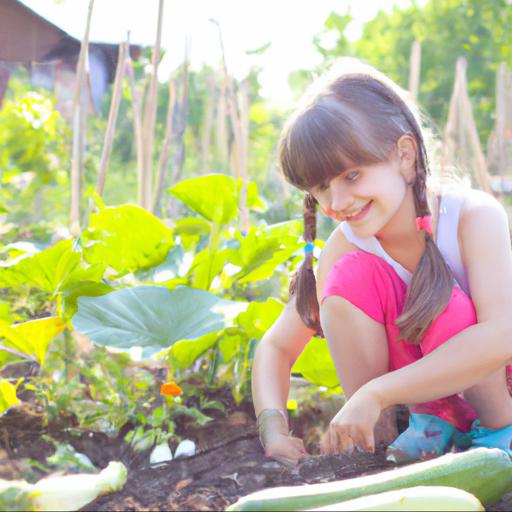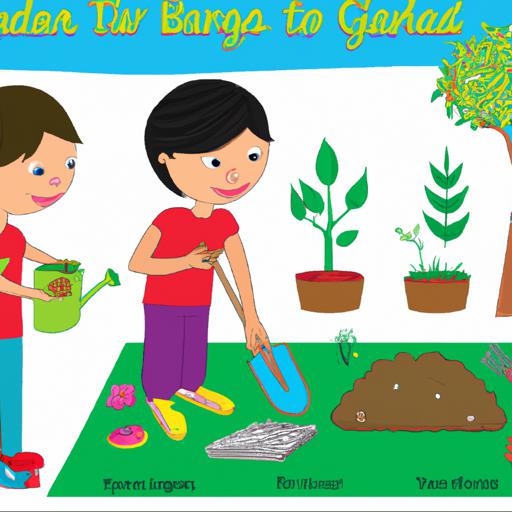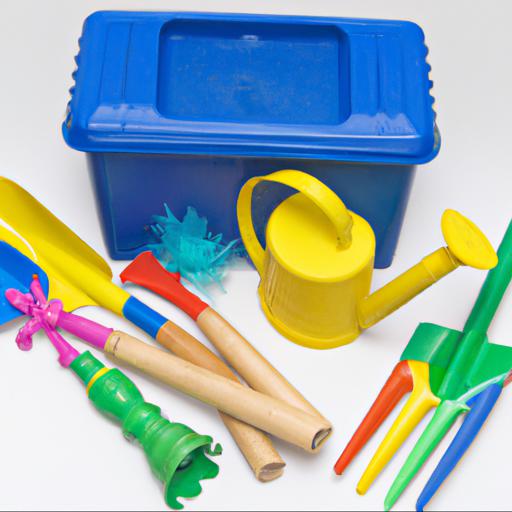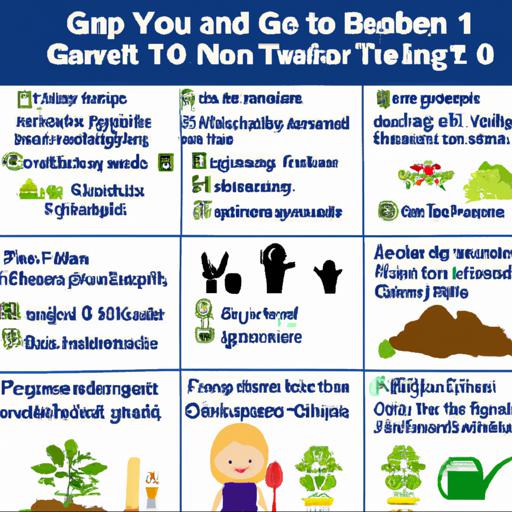Gardening with children can be a fun and rewarding experience. It can help foster a love of nature and give children a sense of accomplishment. If you’re looking for ways to help your children enjoy gardening, here are 10 tips to get you started.
From choosing the right tools to planning activities that encourage exploration and learning, these tips will help you get the most out of your gardening with children experience.
Benefits of gardening with children

Gardening with children can be an incredibly rewarding experience for both you and your little ones. It provides them with outdoor exercise, fosters responsibility, and teaches appreciation for the environment. The best part is that your kids can learn a lot of valuable lessons and have tons of fun at the same time.
Here’s a quick guide on how to get your children to take the initiative and start gardening with you. First, kids love to explore and get messy, so leave space in your garden for them to do just that.
When digging in the dirt, they can discover all kinds of living creatures, as well as learn about plant structures and shapes. Make sure to have tools handy, like buckets and trowels, so they can have fun uncovering rocks, fossil stones, and insects.
If you’re growing vegetables, have them help out during the planting process. This gives them the chance to get their hands in the dirt and see their results firsthand via the fruits of their labor. When it comes to maintaining the health of your garden, let the kids be involved.
Having them measure and mix dirt, compost, and water gives them an opportunity to understand techniques for soil conditioning. Teaching them how to spot potential threats like slugs, pests, and weeds can help them take on a proactive approach early on. It’s also key to educate them about the importance of patience, as gardening requires waiting and observing plants before taking any further steps.
Finally, don’t forget to reward your children for the work they’ve done. Going for a walk together to check the plants’ development or making fun projects together like making cute plant holders is a great way to show your appreciation and keep their interest in gardening alive.
In conclusion, gardening with children can be a great learning experience in more ways than one. With a bit of dedication, your kids will soon be pushing you to the side and taking the helm of their own garden projects. With the tips above, you’ll be well on your way to having your children as proficient gardeners in no time.
Tips for gardening with children

Whether you’re keen to introduce your children to the joys of gardening, or you’ve inherited a green-fingered youngster, here are 10 tips to make sure that everyone enjoys gardening with children. Firstly, get children involved in the planning.
Choosing the right plants and sizes can be made into a fun activity and create a sense of ownership and engagement. Secondly, make it relevant to them. Use their interests to suggest ideas or find plants with unusual colour combinations they’ll enjoy.
Thirdly, remember that gardening starts with the soil. Show them how plants turn the soil into food that nourishes the plants to keep them growing. Explain which materials are the best for the soil, from compost to mulch and provide trowels, rakes, mini wheelbarrows, trugs, and other gardening tools for them to use.
Fourthly, minimize distractions by finding a section of your garden that is just for them. If you don’t have enough space for them to have their own area, create a kitchen garden where they can grow food that they can then use in cooking.
If there’s space, why not allot them a vegetable patch or fruit garden!Fifthly, create a schedule with them. Put aside appropriate tasks they can do in seasons like sowing, planting, weeding, composting and of course rewards like harvesting and tasting the fruits of their labor.
Ensure that the list matches the age and ability of the child and set realistic goals with achievable milestones to reach. Sixthly, let them get creative.
Let them design their own raised beds, grow their own mini-meadow areas and make their own mini herb garden. Seventhly, let them learn by doing. Set up a bird watching station and plant bird-friendly trees and plants. Show them frogs, lizards, and butterflies, and let them hide and find specimens in the garden. Eighthly, bring the story alive with visits to various types of gardens and parks. What better way to inspire and educate about healthy living and make connections between nature and humanity? Ninthly, document the transformation of your garden throughout the seasons. Use pictures and drawings as well as words to record the journey of growing plants and create a scrapbook of memories. Finally, plant something that will give back. As a reward for all the hard work in the garden, donate some money or a portion of the harvest they helped to cultivate to a local charity. This is an excellent way to encourage children to care for those around them, while instilling a sense of community and connectedness. These tips will make it easier to garden with children, ignite their imagination and confidence, and inspire the whole family to play an active part in the great outdoors. with children or not, gardening is an activity to be enjoyed by everyone!
Supplies needed for gardening with children

:As a UK garden expert, I would like to share my top 10 tips for successfully gardening with children. With the right supplies and guidance, gardening is an exciting activity for children of all ages. It provides a chance for children to explore nature, develop new skills and be creative.
As a starting point, there are a few key items that you will need in order to make the most of gardening with children. These include wellington boots, waterproof protective clothing and sturdy tools.
It is also wise to invest in quality tools and supplies that are designed to be safe for children to use. To protect the garden, purchase some weed resistant sheeting and secure it in place at the beginning of the season. In terms of gardening specifically, you will require some larger tools such as a pitchfork and spade, as well as a range of hand tools like trowels, rakes and secateurs.
Ensuring that these tools are of good quality will make gardening easier and safer. It also helps to provide children with smaller gardening tools such as watering cans, watering wands and cultivators that are designed to fit their hands and build their confidence.
Finally, provide a selection of seeds, compost and growing mediums that are safe for children to handle. Be sure to include some interesting options such as sunflowers or beans with bright colours or amazing shapes. By providing children with the proper supplies, you can make gardening a positive, engaging, and educational experience for them.
Fun activities to do while gardening with children
As a UK gardening expert, I’m often asked for tips on how to make the most out of gardening with kids. Gardening is a wonderful hands-on activity that encourages kids to explore nature and its creatures with wistful wonder.
Whether you’re an experienced gardener, novice green-finger, or just starting to dip your toe into the great outdoors, these 10 tips will help make gardening an exciting and educational experience for children of all ages. Firstly, go for easy plants that are likely to grow well with a bit of loving care. This will help to avoid any potential disappointment for the children and make for a more successful and rewarding experience.
Vegetables and flowers are both good choices to get them going. You could even try a “grow your own” kit with a selection of seeds already put together. Secondly, get kids involved in the planning stages of your garden.
Let them have some control by suggesting ideas and making decisions. By offering them a chance to have their input they will feel more connected to the final outcome, adding to their feel of pride.
Thirdly, break the job up into manageable chunks by setting realistic goals with the time available. Be sure to provide plenty of ‘playtime’ in there too, as exploring, touching and playing in the dirt is an integral part of the experience and helps kids learn in a practical and hands on way.
Fourthly, provide the right tools for the job. Make sure you have the suitable tools for the age of your child, such as children’s sized trowels and forks. Also keep safety in mind by making sure that sharp tools are kept out of reach.
Fifthly, make sure you allow for some creative play. Nature provides plenty of material for kids to express their imaginations. From fashioning mud pies and using stones as counting tools, to constructing critter homes from twigs and grass – encourage creative and open-ended play-based learning. Sixthly, involve children in the harvesting process when ready. Give them the opportunity to eat the fruits of their labour and receive the rewards of the time and effort they’ve put in. Throwing a vegetable dinner party with their produce will provide a lasting memory and sense of accomplishment. Seventhly, provide guidance as needed and be available to answer any questions they may have. Surveillance is especially important if you have toddlers around, but older children should be given the freedom to explore and learn independently. Eighthly, consider setting up a bug hotel or butterfly feeding station. This will help introduce the children to all sorts of creepy crawlies and migrating insects that often pop in and out of the garden. Ninthly, nurture an appreciation of nature. Nurturing a love for nature and fostering respect for the environment helps create a lifelong love of the outdoors. Make it a big adventure and encourage children to hike, explore and observe nature in the nearby areas. Ask them to go out and search for bird nests or watch ladybirds in the garden. Finally, use storytelling to capture their imagination. Make up stories about particular plants, their magical powers, their wild travels and big adventures – this will keep them excited and engaged in the garden. In conclusion, there are lots of ways to make gardening an exciting and educational experience for both you and your children. With a bit of preparation and planning, you can have a great time and create memories that will last a lifetime.
Benefits of gardening with children: how gardening can help kids learn and grow
When it comes to teaching your children the importance of nature, gardening is the perfect activity. Gardening with children has many benefits, from teaching them social and environmental responsibility to enhancing their critical thinking skills. Here are 10 tips to help you get the most out of gardening with your children.
Start simple.
Introduce your children to gardening on a small scale. Tiny pots, beds and containers make great projects for younger children.
That way, your kids can enjoy the rewards of their work, while learning the basics at their own pace. Set you and your children up for success.
Pick a good time of day and location to garden, and make sure everyone has the right tools—from small hands to comfortably sized spades and rakes. Involve your children in all aspects of gardening.
Let them help you plan and shop for plants, plant the seeds, and then care for the plants. When appropriate, let your kids choose the plants they want to raise.
Explain the cycle of gardening. From planting to enjoying the fruits of your labor, explain the process to your children. Talk to them about the sun, water, and soil, and how each brings a different element to the garden. Incorporate mathematics. Consider having your children measure the garden space and plan out the plant placement with paper. Show how math is used in gardening and life. Stress observation. Have your children keep an eye on the garden’s progress. Point out the changes in the leaves, petals, and soil. Add to the fun. Use colored rocks, or put up a wind chime to attract birds. Plant a variety of plants that children can watch bloom. This will keep them engaged and increase their interest in the garden. Use nature as a learning tool. Have children identify the different parts of a plant, or experiment with various soil types. Connect to the world. When appropriate, teach your children about endangered species, climate change, and other environmental threats gardeners can help prevent. Share the pride. Harvest the produce with your children and celebrate the success. Host a party or bake something special with the food they’ve grown. Show your kids that they’ve made a difference. Gardening is an activity you and your children that the whole family can enjoy year-round—and there are plenty of ways to take advantage of the educational opportunities and Nature’s bounty gardening offers. With these 10 tips, you and your children can start gardening and learning together right away.
Tips for gardening with children: how to get started and what to consider
As a gardening expert in the UK, I am here to provide tips for parents and carers who are looking to get their little ones involved in the wonderful world of gardening. Gardening is a great activity for children to enjoy, as it helps to develop various skills, including patience, problem-solving and an appreciation of the environment.
It can be a wonderfully rewarding experience that allows children to explore the outdoors and connect with nature. But where do you start when it comes to teaching children about gardening?Firstly, it’s important to explain the basics of gardening to children before they begin.
Talk them through the different tools they’ll be using and describe the variety of plants they’ll be caring for. You could also discuss the importance of soil health and how to measure essential elements like pH and light.
When planning your gardening activities, try to involve them from the beginning. Ask questions like “What do you want to grow?”, or “What type of tool you would like to use for this task?
” This way, you’re empowering the children to voice their own ideas and make decisions about their activities. Once you’ve created a comfortable and safe environment, you can start your project.
Begin with simple activities, like potting and repotting plants, or weeding. Throughout this process, be sure to explain the origins of the plants and discuss how living things grow. You should also be aware of your children’s time limits.
Being outdoors can be a joyous experience, but if it’s prolonged, it can become tiresome. Give your children regular breaks and remember to change activities as quickly as they lost interest. In order to maintain their enthusiasm, reward your children with a treat every now and then. You could also invest some time into decorating your garden area: they’ll appreciate the extra effort and enjoy discovering it the next time they visit the garden. Finally, go exploring! Take your children to a neighbouring nature reserve, or visit a botanical garden. This is a great opportunity for your children to observe and learn about an array of plants and animals. Plus, after all the hard work, it’s also a great chance for them to take a break and appreciate nature. These are just a few tips for kickstarting your children’s journey into gardening. Gardening can be an invaluable experience for young minds; introducing children to plants and nature will open up a world of opportunities for your little ones to learn and explore.
Supplies needed for gardening with children: what you need to get started
Gardening with children can be a great way to teach them about nature and to express their creativity. It can also help promote healthy lifestyle habits and teach them about caring for the environment. However, before you start gardening with children, you need to make sure that you have the supplies needed to make it a successful experience.
Here are ten tips for gardening with children to help you get started on the right foot. Firstly, make sure you have the right tools and supplies.
Include basics like a hoe, rake, trowel, and bucket, but also garden gloves, trowels and pruners sized just right for children, some hand tools, a wheelbarrow, soil sample tester, compost bin and watering can. Secondly, ensure that any materials you use are safe and non-toxic. If you plan to have kids help in the garden, it’s important to double-check that your garden products, such as fertilizers, are not harmful to them.
Thirdly, provide outdoor clothing that is comfortable and practical. Kids love to engage in outdoor activities, but you want them to be safely shielded from the sun and weather.
Perfect for this occasion is a wide-brimmed hat, garden clogs or rubber boots, and clothing that covers their arms and legs. Fourthly, consider having an outdoor kitchen available for kids to use. This encourages them to explore food, nutrition, hygiene and even science.
An outdoor kitchen could include items for growing and cooking food, a set of measuring tools and pots and pans. Fifthly, provide children with books that relate to gardening.
Introduce them to their favorite characters and teach them about plants, insects, and animals to help them appreciate the environment. Sixthly, have a compost bin nearby so they can learn and apply responsibility. This compost should be considered an outdoor classroom and be easily accessible to kids so they can collect fallen leaves, weeds and other organic materials. Seventhly, offer a variety of plants and vegetables. Kids are more likely to be interested in gardening if they can dig, plant, weed and tend to some of their favorite vegetables and fruits. Eighthly, have plenty of seating and resting areas within reach for kids so that they can take a break whenever they need it. Ninthly, always include safety precautions and teach kids how to move between plants and pathways without trampling the plants or getting scratched by thorns. Finally, create fun activities and reward systems for the kids. Grow sunflowers and other flowers that kids can take turns in watering, plan an occasional scavenger hunt or have a contest to see who can plant the most seeds. You’ll be surprised at how involved and excited the kids can get. By being prepared and taking the tips mentioned above into consideration, you can help make gardening with children a fun and educational experience. With the right supplies and activities in place, your garden should be full of life and filled with laughter.
Fun activities to do while gardening with children: ideas to make gardening fun for kids
. Gardening with children can be a fun and rewarding experience for both parents and kids alike.
It helps to foster an appreciation for nature, encourages exploration and social interaction and provides an education in responsibility and work ethic through hands-on activities. But, as gardeners know, tuning into the Earth can also open up many interesting conversations and playtime opportunities. Here are 10 tips to make sure you and your children are having a great time while gardening together.
First of all, it’s important to be well prepared before you start gardening with your kids. Teaching children the basics of garden planning and preparation will help to ensure a successful and enjoyable experience. Lay out a plot for the plants, make sure your soil is ready for planting, and select a range of easy-to-maintain plants for your kids to work with.
Once you get started, let kids explore and be creative. Encourage them to play in the dirt and examine seeds, leaves and flowers up close.
Even something as simple as discovering different colors and shapes can keep kids engaged for hours. Also, provide them with their own tools – child-safe trowels, watering cans, gloves and gloves are great to get them involved and feeling like they are engaged in the actual process. Then, break up the work with activities and games to keep them motivated.
Have them make a scavenger hunt that involves finding specific colors and shapes or have them create artwork and structures out of natural supplies found within the garden. Nature-inspired games such as rock tossing or stick archery are also great ways to have some fun.
These are just a few tips to help you make gardening with your children a fun and rewarding experience. By involving them in tasks and activities, you can create moments that both you and the kids will remember for years to come.
Bottom Line
Gardening with children can be a fun and educational activity. Here are 10 tips to help you get started: choose a spot that is easy to access, provide tools and supplies that are age-appropriate, involve children in the planning process, encourage curiosity, let them get their hands dirty, let them help with watering, provide guidance and support, allow for mistakes, make it fun, and be sure to celebrate successes.
FAQ
What age is appropriate for children to start gardening?
It is appropriate for children to start gardening at any age, depending on their level of interest and maturity. For younger children, it is best to start with activities such as watering plants, pulling weeds, and collecting seeds. As they get older, they can gradually take on more complex tasks such as planting, pruning, and harvesting.
What are some of the benefits of gardening with children?
Some of the benefits of gardening with children include teaching them about nature and the environment, fostering a sense of responsibility and ownership, encouraging healthy eating habits, and providing an opportunity for physical activity. Gardening can also help children develop problem-solving skills, build self-esteem, and promote creativity.
What are some of the safety considerations when gardening with children?
Some safety considerations when gardening with children include wearing protective clothing, such as gloves, long pants and closed-toe shoes; using age-appropriate tools; supervising children at all times; avoiding the use of chemicals; and teaching children to identify and avoid poisonous plants.
What are some fun activities that can be done while gardening with children?
Some fun activities that can be done while gardening with children include planting seeds, making mud pies, creating a scavenger hunt, and making a garden journal.
What are some of the best plants to grow with children?
Some of the best plants to grow with children include sunflowers, pumpkins, beans, radishes, carrots, and herbs.
What are some tips for teaching children about gardening?
1. Start with a small project, such as planting a few vegetables or flowers in a pot or small garden bed. 2. Involve children in the planning process by asking them what they would like to grow and helping them research the best plants for their area. 3. Make it fun by playing games while gardening, such as counting the number of weeds or finding the biggest bug. 4. Explain the importance of gardening and how it helps the environment. 5. Allow children to take ownership of the garden by giving them tasks such as watering, weeding, and harvesting. 6. Celebrate successes by having a garden party or taking photos of the garden’s progress.

